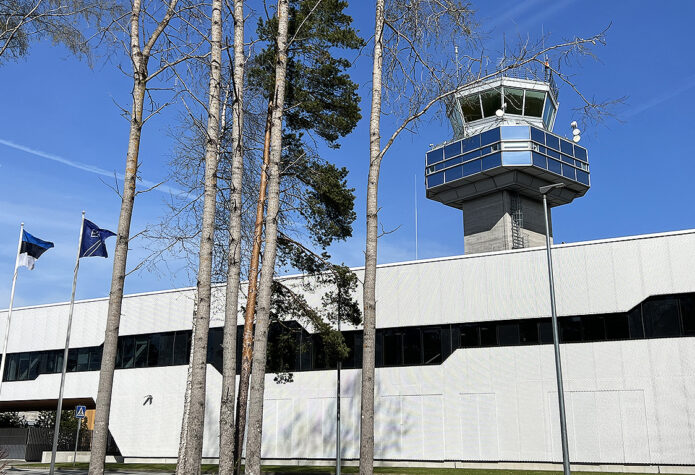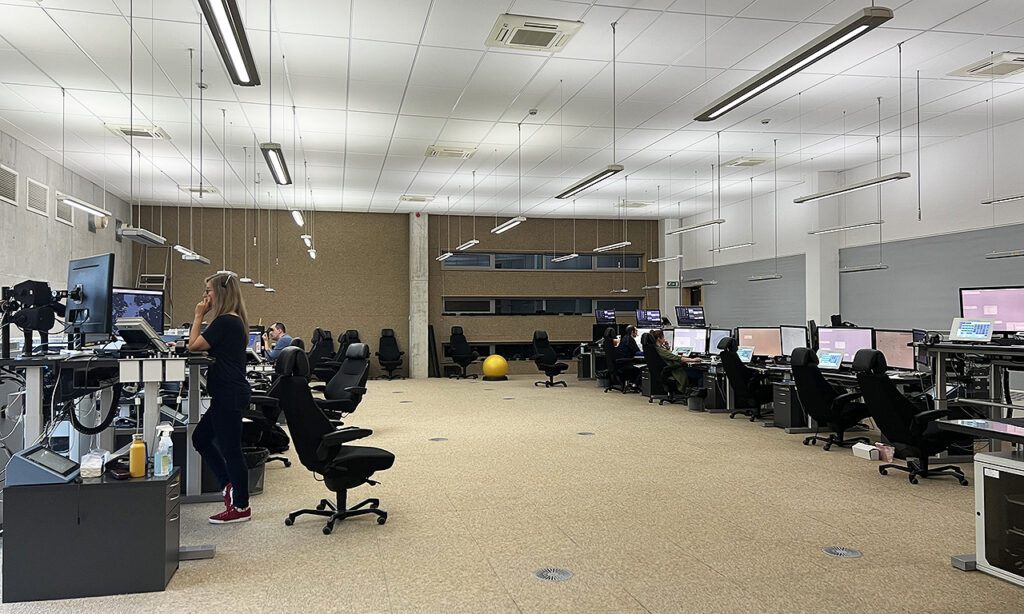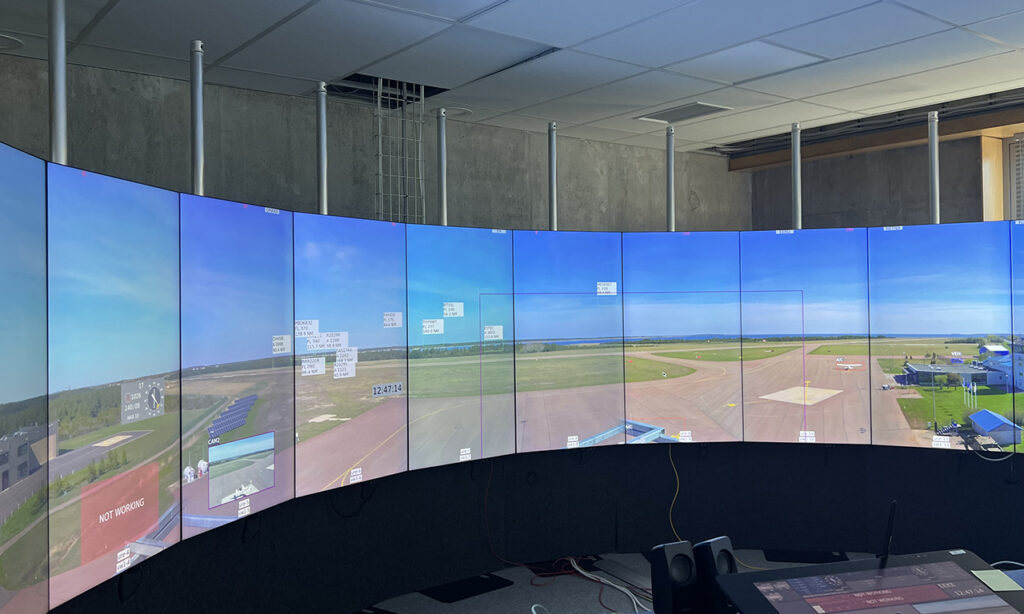Setting course for the future of aviation

Frequent flyers are probably familiar with the air control towers at airports. Years from now, however, these high-reaching structures may no longer be needed. Even more so, air traffic controllers may not even need to be in the country whose air space they are managing. To learn more about this, NIB visited the Estonian Air Navigation Services (EANS), where the Bank is financing developments that aim to transform the industry.
On this Tuesday afternoon, Tallinn airport is rather quiet, allowing us to chat with the passengers and staff as we wait for our visit to the EANS. Ingrid, who works at the airport’s information desk, says that although the number of flights has been picking up lately, they are still behind pre-Covid levels.
“You know, we had a TV show about air traffic controllers,” she says when asked about what she thinks air traffic control entails. “Their job is to monitor the airspace – to not let the aircraft come together. They communicate between the pilots and the airport.”
Ingrid is referring to the 2019 documentary “Estonian Skies: The Invisible Guides”, which first opened the heavily secured doors of the EANS. It deep dived into the daily lives of air traffic controllers, highlighting both the rewarding responsibilities and the stress factors that come with “trying to keep the dots on the radar apart”.
But as the pandemic has been reshaping the entire travel industry, other transformations have also been taking place within the aviation sector itself. Just a five-minute ride from the airport, we soon learn that air traffic control has changed in the few years since the documentary was released.
Cross-border services ready for take-off
“Our job is to ensure the safety of the skies of the Estonian territory and over its open waters. We do everything for that reason, and that is the purpose of our work,” explains Ivar Värk, CEO of EANS, as we start from the same question we asked the passers-by earlier. NIB is visiting the Estonian air traffic management services provider to sign a EUR 13 million loan agreement for the company’s investments programme for 2022–2025.
“It helps us improve efficiency and do innovative in-house projects,” says Värk on the importance of this financing. “We’re quite a small company compared to the rest of Europe, but we’re trying to be the first to do something.”

Indeed, some of the investments are aimed at just that. It entails the implementation of the FINEST programme, a bilateral cooperation between EANS and Fintraffic ANS Finland – the first attempt of its kind in Europe to combine the airspace of two countries. Once completed, it will not only optimise services by creating a cross-border air traffic management system between Estonia and Finland, but also allow the controllers to operate flights across national borders.
“One of the ideas behind FINEST is that we can allocate controllers in positions where we need them. For example, during the night, when there are only a few aircraft above Estonia and Finland, there are two air traffic controllers on duty – one for each airspace. In future, we’ll be able to allocate one controller who can manage both. When the flight intensity is higher, we’ll be able to allocate more. All in all, this means we can let more traffic through the combined airspace,” explains Värk.
Steering the change in the industry
Värk says that although the cooperation between EANS and Fintraffic ANS is pretty unique, it is also an example of how air traffic management will be done in the future. The project serves as a model for the European Union’s Single European Sky initiative, which aims to reform Europe’s air travel to ensure the safest, most cost-effective and flight-efficient and environmentally friendly conditions.
“The air traffic business in Europe is quite fragmented. There are 37 service providers covering 51 FIR’s (flight information regions) on our continent, which, compared to the United States, make us not so competitive,” says Värk on the challenges facing the industry. “Each provider procures expensive air traffic management (ATM) systems, yet even the procurement procedures between different countries are different. The training needed to work with air traffic management is also quite complex. All this means the air traffic control monster is not very efficient.”
“Because we have many state actors with different laws and different sovereignty issues, Europe will never be as efficient as the US. But we can improve by fostering cooperation – we want to show the rest of Europe how it’s possible,” says Värk.
One tower to rule them all?
As we continue our tour around the EANS facilities, we encounter more things we had previously thought impossible. Unlike what we used to think, not all air traffic control needs to take place from the top of the towers overseeing aerodromes.
In one of the control rooms, an EANS controller is managing the air traffic in Tartu airport with the help of 16 huge screens. In April this year, Tartu airport became the first in Estonia to shift its air traffic services from a physical to a remote tower.

By the end of 2025, Kuressaare, Pärnu and Kärdla airports are also expected to move to fully remote air traffic management, enabling EANS to provide air traffic services for all the regional Estonian airports from a single location. This will not only improve flexibility and decrease costs, but will ensure safe and high-quality services, regardless of the weather conditions.
“We’re the sixth country in the world that can control the air traffic from a distance,” says Värk, explaining that the entire system has been fully developed in Estonia. He adds the implementation has already received a lot of interest, and there are plans to sell the solution to other providers. Just like cross-border air traffic management, remote control towers are expected to be the future of the aviation industry.
Sustainable developments help in adapting
While location-independent air traffic control services can help mitigate the weather factor, they also play a role in making the whole industry more sustainable. “We no longer need to build monstrous buildings that use so much energy at every airport. And the maintenance is much cheaper,” says Värk.
“At EANS, sustainability has always been important. We enabled free route airspace years ago. This means the aircraft going through our airspace can choose their trajectory – they no longer have to go in zigzags,” adds Värk, explaining how optimised routing can lead to lower fuel consumption and reduce CO2 emissions.
According to him, shifting to more sustainable air traffic management is essential for the whole aviation industry.
“Air travel is recovering after Covid, but it won’t be quick. Also, the sanctions on Russia will remain,” says Värk. “These two crises have shown that something that is hard to predict and out of your control can hit you at any time. That’s why the variety of services is very important.”
“This is the key to surviving – you need to be able to manage both low- and high-traffic situations. It is exactly projects like this one that NIB is financing that will make the future successful,” Värk concludes.

